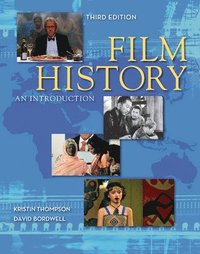
- Format
- Häftad (Paperback)
- Språk
- Engelska
- Antal sidor
- 800
- Utgivningsdatum
- 2009-03-16
- Upplaga
- 3
- Förlag
- McGraw Hill
- Medarbetare
- Bordwell, David
- Illustratör/Fotograf
- illustrations
- Illustrationer
- illustrations
- Dimensioner
- 272 x 216 x 28 mm
- Vikt
- Antal komponenter
- 1
- Komponenter
- GAMEBOARD
- ISBN
- 9780073386133
- 1680 g
Kundrecensioner
Fler böcker av Kristin Thompson
-
Minding Movies
David Bordwell, Kristin Thompson
-
The Classical Hollywood Cinema
David Bordwell, Janet Staiger, Kristin Thompson
-
The Frodo Franchise
Kristin Thompson
-
Storytelling in Film and Television
Kristin Thompson
Övrig information
Kristin Thompson is an Honorary Fellow in the Department of Communication Arts at the University of WisconsinMadison, where she earned her Ph.D. Her books include Eisensteins Ivan the Terrible (1981), Exporting Entertainment: Americas Place in World Film Markets 19011934 (1985), Breaking the GlassArmor: Neoformalist Film Analysis (1988), Storytelling in the New Hollywood:Understanding Classical Narrative Technique (1999), Herr Lubitsch Goes to Hollywood: German and American Film after World War I (2005), and The FrodoFranchise: The Lord of the Rings and Modern Hollywood (2007).
David Bordwell is Jacques Ledoux Professor Emeritus of Film Studies in the Department of Communication Arts at the University of WisconsinMadison. He also holds a Hilldale Professorship in the Humanities and an Honorary Doctorate from the University of Copenhagen. He has also held the Kluge Chair in Modern Culture at the Library of Congress. His books include Narration in the Fiction Film (University of Wisconsin Press, 1985), On the History of Film Style (Harvard University Press, 1997), Planet Hong Kong: Popular Cinema and the Art of Entertainment (Harvard University Press, 2000; 2nd ed., Irvington Way Institute Press, 2011), Figures Traced in Light: On Cinematic Staging(University of California Press, 2005), The Way Hollywood Tells It: Story and Style in Modern Movies (University of California Press, 2006), The Rhapsodes: How 1940s Critics Changed American Film Culture (University of Chicago Press, 2016), and Reinventing Hollywood: How 1940s Filmmakers Changed MovieStorytelling (University of Chicago Press, 2017). He has also written books on Carl Theodor Dreyer, Yasujiro Ozu, Sergei Eisenstein, digital cinema, and Hong Kong film.
